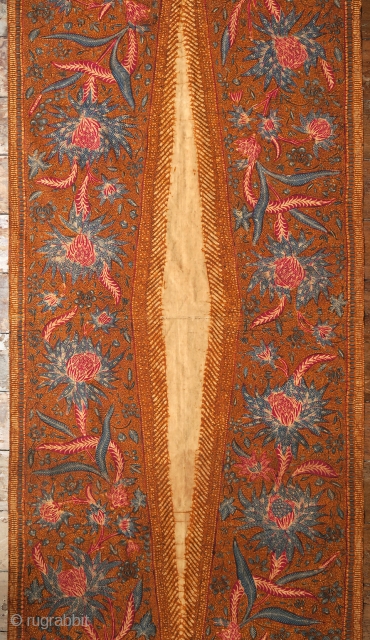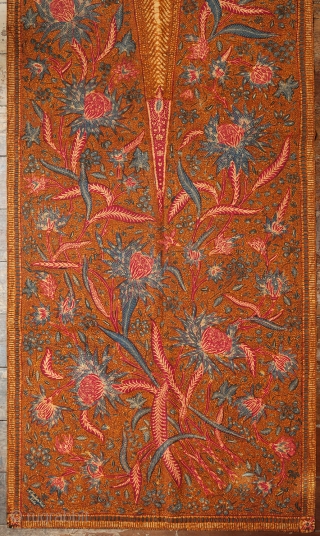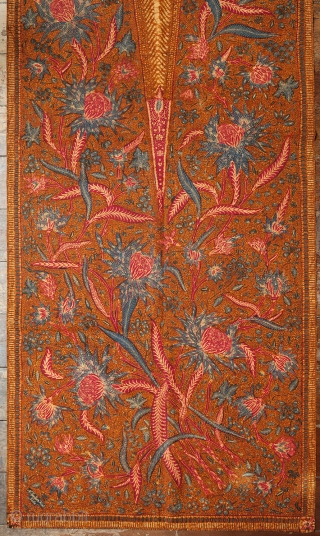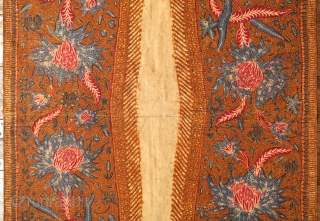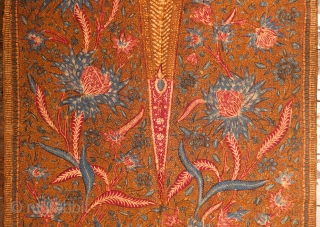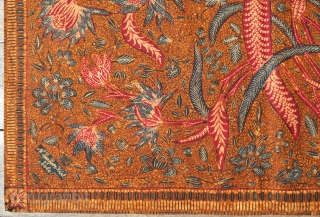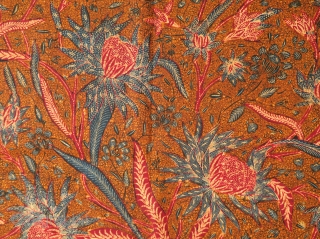Back
Javanese Batik Breastcloth made in 3 States (Kemben Batik Tiga Negeri)
Origin: Java, Solo / Lasem / Pekalongan, 1900 - 1920
Technique: Natural dyes, hand-drawn batik (tulis)
Description: a fine breastcloth (kemben) hand-drawn separately in Solo, Lasem, and Pekalongan to create a rich, dramatic design that blends their 3 distinct styles. The ceremonial format juxtaposes the cream elongated diamond (tengahan) reserved in the center with a surrounding design of scattered rich blue and lacquer red blossoms and leaves. The sparkling blue chrysanthemum petals drawn in Pekalongan are filled with different tiny patterns, enhancing the richness of the design; the warm, golden soga brown bands drawn in Solo have soft cream dots (cocohan) that represent rice seedlings, thus making the whole design a metaphor for padi. The long red leaves and chrysanthemum centers drawn in Lasem are detailed with the signature cream foliated motifs of Lasem that give a bold, graphic note to the pattern. The 3 different styles create a graduated contrast of soft brown ground overlaid with bright crisp blue-and-white detail and intense, dramatic red highlights – a uniquely luxurious, yet delicate, effect. The diagonal flames (cimukirran) forming the inner border of the central diamond are defined by an irregular shading of brown created by crackling (made by cracking the wax during the batik process), that gives a glowing effect of dappled light. The piece is signed in the corner by the maker: “Nj. Tjoa Tjoen Kiat, Solo”.
Context: Tiga negeri batik evolved from dua negeri (2 states) batik, which often organized a more simple division of styles between 2 parts of the design. Whereas dua negeri could be copied in one workshop, it was extremely difficult to simulate the expertise required for 3 different styles. a tiga negeri batik was usually begun by Peranakan Chinese batik entrepreneurs, in Pekalongan or Lasem, where the principal pattern was waxed and partially dyed. The cloth was then taken to another north coast town where a new color and part of the main as well as background pattern were added. Lastly, it was brought to Solo or Yogyakarta where the background was completed in traditional central Javanese motifs and colors. The batikers in central Java had considerable freedom with the background and final design of the textile; the lovely cocohan drawn in Solo on this batik is now a lost technique.
The intention of the genre was to combine the best of the different regional styles of batik. Tiga negeri batik was the most expensive batik of its time: whilst the entrepreneurs may have saved costs by getting the background made in central Java, where batik labor was cheaper, the coordination and transport required also multiplied costs. As a luxury item that declared one’s status, tiga negeri batik was worn by wealthy Peranakans who wished to show their affiliations with traditional Javanese culture, and was also favored as informal private wear in the central Javanese courts. Its cosmopolitanism had the inadvertent effect of making the batik styles of one region familiar in another, leading to the greater sharing of motifs. The format of this breastcloth with a central reserved section is one of the oldest types of ceremonial ritual court batik; at the same time, it incorporates the colors and finely detailed floral motifs typical of the north coast, in a multidirectional design that pre-dates the bouquets introduced by Indo-European batik-makers, and imitates the scattering of blossoms in ritual.
Condition: The textile is in almost perfect condition, except for wear along the central fold line that is beginning to tear. The red is deep and vivid, the blue fresh and glowing, and the soga brown is rich and unfaded. The cotton is of the highest grade, fine, smooth, thick and waxy, and quite crisp and cool to the touch.
Dimensions: 253 cm x 51.5 cm.
Origin: Java, Solo / Lasem / Pekalongan, 1900 - 1920
Technique: Natural dyes, hand-drawn batik (tulis)
Description: a fine breastcloth (kemben) hand-drawn separately in Solo, Lasem, and Pekalongan to create a rich, dramatic design that blends their 3 distinct styles. The ceremonial format juxtaposes the cream elongated diamond (tengahan) reserved in the center with a surrounding design of scattered rich blue and lacquer red blossoms and leaves. The sparkling blue chrysanthemum petals drawn in Pekalongan are filled with different tiny patterns, enhancing the richness of the design; the warm, golden soga brown bands drawn in Solo have soft cream dots (cocohan) that represent rice seedlings, thus making the whole design a metaphor for padi. The long red leaves and chrysanthemum centers drawn in Lasem are detailed with the signature cream foliated motifs of Lasem that give a bold, graphic note to the pattern. The 3 different styles create a graduated contrast of soft brown ground overlaid with bright crisp blue-and-white detail and intense, dramatic red highlights – a uniquely luxurious, yet delicate, effect. The diagonal flames (cimukirran) forming the inner border of the central diamond are defined by an irregular shading of brown created by crackling (made by cracking the wax during the batik process), that gives a glowing effect of dappled light. The piece is signed in the corner by the maker: “Nj. Tjoa Tjoen Kiat, Solo”.
Context: Tiga negeri batik evolved from dua negeri (2 states) batik, which often organized a more simple division of styles between 2 parts of the design. Whereas dua negeri could be copied in one workshop, it was extremely difficult to simulate the expertise required for 3 different styles. a tiga negeri batik was usually begun by Peranakan Chinese batik entrepreneurs, in Pekalongan or Lasem, where the principal pattern was waxed and partially dyed. The cloth was then taken to another north coast town where a new color and part of the main as well as background pattern were added. Lastly, it was brought to Solo or Yogyakarta where the background was completed in traditional central Javanese motifs and colors. The batikers in central Java had considerable freedom with the background and final design of the textile; the lovely cocohan drawn in Solo on this batik is now a lost technique.
The intention of the genre was to combine the best of the different regional styles of batik. Tiga negeri batik was the most expensive batik of its time: whilst the entrepreneurs may have saved costs by getting the background made in central Java, where batik labor was cheaper, the coordination and transport required also multiplied costs. As a luxury item that declared one’s status, tiga negeri batik was worn by wealthy Peranakans who wished to show their affiliations with traditional Javanese culture, and was also favored as informal private wear in the central Javanese courts. Its cosmopolitanism had the inadvertent effect of making the batik styles of one region familiar in another, leading to the greater sharing of motifs. The format of this breastcloth with a central reserved section is one of the oldest types of ceremonial ritual court batik; at the same time, it incorporates the colors and finely detailed floral motifs typical of the north coast, in a multidirectional design that pre-dates the bouquets introduced by Indo-European batik-makers, and imitates the scattering of blossoms in ritual.
Condition: The textile is in almost perfect condition, except for wear along the central fold line that is beginning to tear. The red is deep and vivid, the blue fresh and glowing, and the soga brown is rich and unfaded. The cotton is of the highest grade, fine, smooth, thick and waxy, and quite crisp and cool to the touch.
Dimensions: 253 cm x 51.5 cm.
price:
SOLD
- Home
- Antique Rugs by Region
- Category
- Profiles
- Post Items Free
- Albums
- Benaki Museum of Islamic Art
- Budapest: Ottoman Carpets
- Gulbenkian Museum
- Islamic Carpets. Brooklyn
- Islamic Textiles. Brooklyn
- Konya Museum: Rugs
- MKG, Hamburg
- MMA: Caucasian Carpets
- MMA: Mamluk Carpets
- MMA: Mughal Indian Carpets
- MMA: Ottoman Carpets
- MMA: Safavid Persian Carpets
- MMA: Turkmen Rugs
- McCoy Jones Kilims
- Ottoman textiles. Met
- Philadelphia Museum
- Rugs and Carpets: Berlin
- Seljuqs at the Met
- TIEM, Istanbul: Carpets
- V&A: Classical Carpets
- Vakiflar Carpets: Istanbul
- Baluch Rugs: Indianapolis
- Gallery Exhibitions
- Jaf an Exhibition
- Alberto Levi Gallery
- Andean Textile
- Christie's London: 2016
- Francesca Galloway
- HALI at 40
- ICOC Washington, DC 2018
- Jajims of the Shahsavan
- London Islamic Week April, 2018
- Mongolian Felts
- Navajo Rugs: JB Moore
- Persian Piled Weavings
- SF Tribal & Textile Art Show 2020
- SF Tribal 2019
- Sotheby's: C. Alexander
- Turkish Prayer Rugs
- Turkmen Main Carpets ICOC 2007







